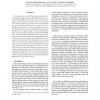Free Online Productivity Tools
i2Speak
i2Symbol
i2OCR
iTex2Img
iWeb2Print
iWeb2Shot
i2Type
iPdf2Split
iPdf2Merge
i2Bopomofo
i2Arabic
i2Style
i2Image
i2PDF
iLatex2Rtf
Sci2ools
98
Voted
DSN
2005
IEEE
2005
IEEE
On Partial Protection in Groomed Optical WDM Mesh Networks
In this paper, we consider the problem of survivable network design in traffic groomed optical WDM mesh networks with sub-wavelength capacity connections. In typical survivable network designs, individual sessions are provided either full protection or no protection. We consider a quality of protection (QoP) framework where a connection is provided partial protection, i.e. when a link failure occurs on the primary path, the protection bandwidth provided on the backup path is less than or equal to the primary bandwidth. Each connection request specifies the primary bandwidth and a minimum backup bandwidth required. The network will guarantee at least the minimum backup bandwidth and, if capacity is available, higher backup bandwidth up to the primary path’s bandwidth. The advantage of such a model is that it can reduce backup capacity requirements based on connection needs leading to lower blocking probability and lower network costs. We consider two scenarios: (i) a network with s...
Backup Bandwidth | Computer Networks | DSN 2005 | Minimum Backup Bandwidth | Survivable Network Designs |
Related Content
| Added | 24 Jun 2010 |
| Updated | 24 Jun 2010 |
| Type | Conference |
| Year | 2005 |
| Where | DSN |
| Authors | Jing Fang, Mahesh Sivakumar, Arun K. Somani, Krishna M. Sivalingam |
Comments (0)

